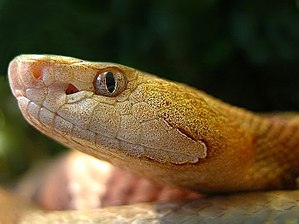North American copper head
| North American copper head | ||||||||||||
|---|---|---|---|---|---|---|---|---|---|---|---|---|

North American copper head ( Agkistrodon contortrix ) |
||||||||||||
| Systematics | ||||||||||||
|
||||||||||||
| Scientific name | ||||||||||||
| Agkistrodon contortrix | ||||||||||||
| ( Linnaeus , 1766) |
The North American copper head ( Agkistrodon contortrix ) belongs with its five subspecies within the family of the vipers (Viperidae) to the genus of the triangular head caterpillars ( Agkistrodon ).
description
The North American copper head reaches a length of around 90 centimeters, in rare cases up to 1.2 meters. Its back has a basic ocher color and is covered with copper-red transverse bands. The cross bands are edged in black. Its flat and triangular head stands out clearly from the body . The head is lighter colored towards the sides. A white stripe runs from the eyes to the corner of the mouth. The snout tapers towards the tip. The pupils are slit vertically. A noticeable feature are its Loreal pits , which are located between the eyes and nostril and are clearly visible. Lorealgruben are organs that allow pit vipers (Crotalinae) temperature differences can perceive.
The North American copper head is a crepuscular and nocturnal snake that hides during the day. Caves in the earth , tree stumps and cairns are its natural retreats. Depending on the area of distribution , the snake hibernates , which can last four to six months.
Subspecies
- Southern copper head ( Agkistrodon contortrix contortrix ) - large parts of the southern states of the USA and northern Mexico
- Broadband Copper Head ( Agkistrodon contortrix laticinctus ) - Texas , Oklahoma, and Kansas
- Northern Copperhead ( Agkistrodon contortrix mokasen ) - large areas of the Southern
- Osage copperhead ( Agkistrodon contortrix phaeogaster ) - Kansas, Missouri
- Trans-Pecos copperhead ( Agkistrodon contortrix pictigaster ) - Texas
distribution
The North American copper head is common with its subspecies in large parts of the southern states of the USA and in northern Mexico. Light forests , wet meadows and mountain regions with heights of up to around 1,000 meters are preferred . The North American copper head can also occasionally be found on agricultural land such as meadows and fields .
food
The North American copper head eats anything it can overwhelm. Its spectrum ranges from small mammals such as mice and rats to birds , reptiles , amphibians and insects . The tip of the tail of the copper heads is strikingly turquoise-green in color and is used as an imitation worm to e.g. B. To attract birds.
Reproduction
In the wild, mating takes place in April and May. The North American copper head belongs to the group of viviparous ( ovoviviparous ) snakes. The gestation lasts about 90 days. In the months of August and September up to 17 young snakes hatch, which are 20 to 25 cm long at birth. They shed their skin for the first time shortly after birth .
In addition to sexual reproduction, facultative parthenogenesis has been demonstrated for the North American copperhead, both in captivity and in the wild . This results in viable offspring from the female's unfertilized germ cells.
Poison
The venom of the North American copper head, a Hämotoxin medium strength, is very painful but not usually fatal for an adult. The symptoms range from local pain to nausea and vomiting .
Because of its toxicity, the copper head is used in the Appalachians for the snake- grabbing ritual practiced by a few American Pentecostal churches .
Trivia
In the American Civil War , the so-called. Peace Democrats who advocated a "peace without victory" and negotiations with the South were called " Copperheads called" (copper heads). Of course, that had only to do with the venomous snake to a limited extent; various sources derive the name from the old copper cent coins that the copperheads wore as pins .
Web links
- Copper head, Agkistrodon contortrix. Entry in the travel portal Goruma
- Agkistrodon contortrix in The Reptile Database
- Agkistrodon contortrix in the Red List of Threatened Species of the IUCN 2013.1. Posted by: Frost, DR, Hammerson, GA & Santos-Barrera, G., 2007. Retrieved October 5, 2013.
Individual evidence
- ^ Warren Booth, Charles F. Smith, Pamela H. Eskridge, Shannon K. Hoss, Joseph R. Mendelson and Gordon W. Schuett (2012): Facultative parthenogenesis discovered in wild vertebrates. In: Biology letters , Volume 8, Number 6, Pages: 983-985, doi : 10.1098 / rsbl.2012.0666


